
Nevsky Prospekt is the main thoroughfare and one of the most popular streets in St. Petersburg, which has a rich history.
Today, Nevsky Prospekt is home to a large number of attractions, including historic buildings, palaces, squares, gardens, cathedrals, and bridges.
Since Nevsky Prospekt is large and has many interesting objects, for the convenience of readers, the description of the avenue is divided into three separate articles:
1. A brief description and history of Nevsky Prospekt, as well as the sights of the most refined and visited part of Nevsky Prospekt - from Alexander Garden to Anichkov Bridge of the Fontanka River (Beloselsky-Belozersky Palace and Literary House). Learn more about the first part of Nevsky Prospekt…
2. This article, which describes Nevsky Prospekt from the Beloselsky-Belozersky Palace and the Literary House to the Vosstaniya Square inclusive. At Vosstaniya Square, the so-called front part of the avenue ends.
3. Description of Nevsky Prospekt from Vosstaniya Square to the end of the avenue - Alexander Nevsky Square and Holy Trinity Alexander Nevsky Lavra. This part of the avenue is unofficially called "Staro-Nevsky Prospekt". Learn more about the third part of Nevsky Prospekt...
This segment of Nevsky Prospekt is 950 meters.
Behind the Anichkov Bridge, which spans the Fontanka River, and is part of Nevsky Prospekt, on the banks of the Fontanka River are two famous and colorful buildings: the Beloselsky-Belozersky Palace (Nevsky Prospekt, 41) and the Literary House (Nevsky Prospekt, 68). Both buildings are described in the first article about Nevsky Prospekt.
Behind these buildings along the Nevsky there are dense rows of buildings, some of which are particularly bright and attractive and are included in the list of attractions of St. Petersburg.
In the historical, now restored buildings there are shops, salons and shopping complexes, cafes, bars and restaurants, there is a museum, theaters, residential premises, accommodation facilities (hotels, apartments) and office space.

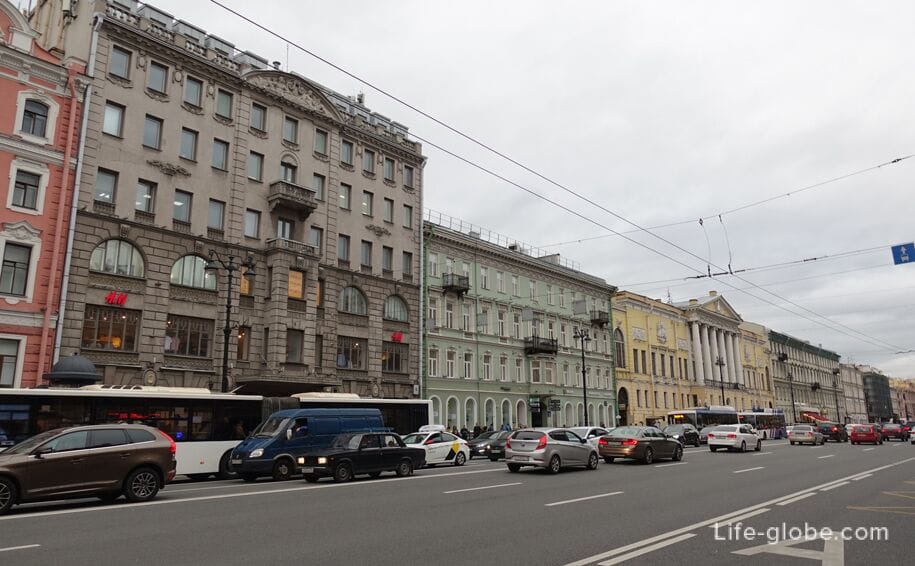

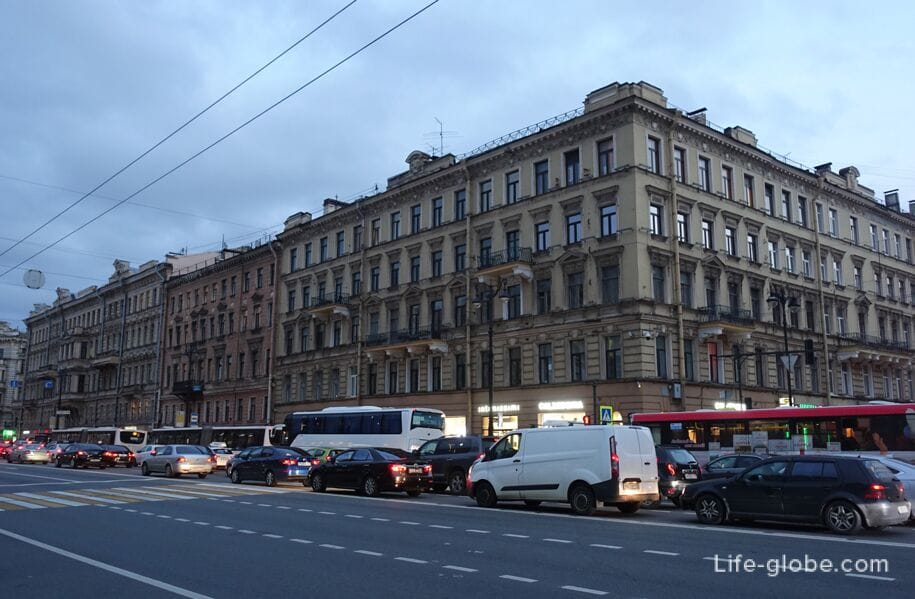
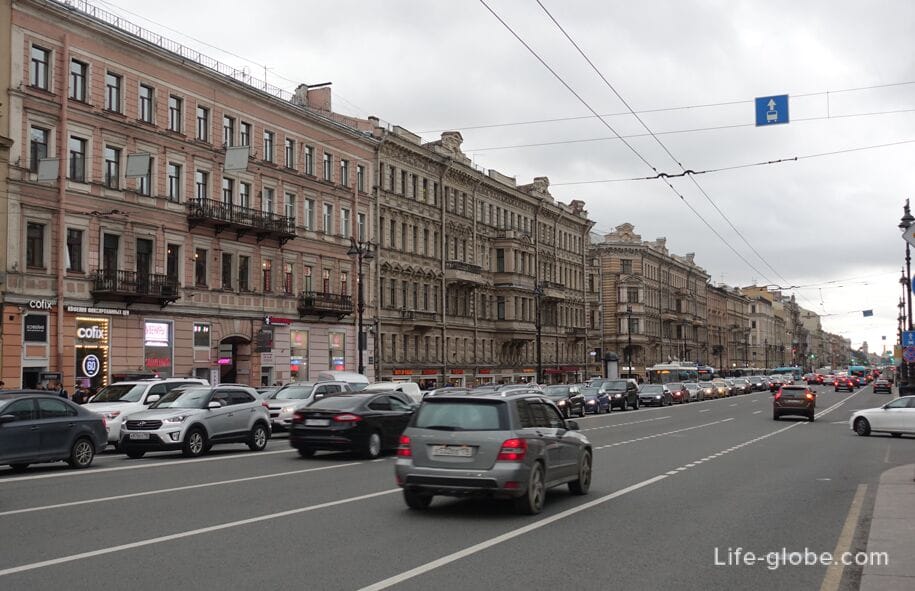
This corner building is located on the corner of Rubinstein Street and Nevsky Prospekt 43.
Initially, this place was a two-story house, which in 1829 was built on one floor by the architect A. D. Nellinger. Then the plot was owned by the court dancer, choreographer and head of the Theater School Sh. L. Didlo.
In 1899, the house was purchased by Grand Duke Sergei Alexandrovich, who owned the nearby Beloselsky-Belozersky Palace. For the new owner, the architect A.V. Kashchenko in 1900, the house was built on two more floors and its facades were redesigned in a Baroque form, in order to architecturally connect it with the neighboring palace.
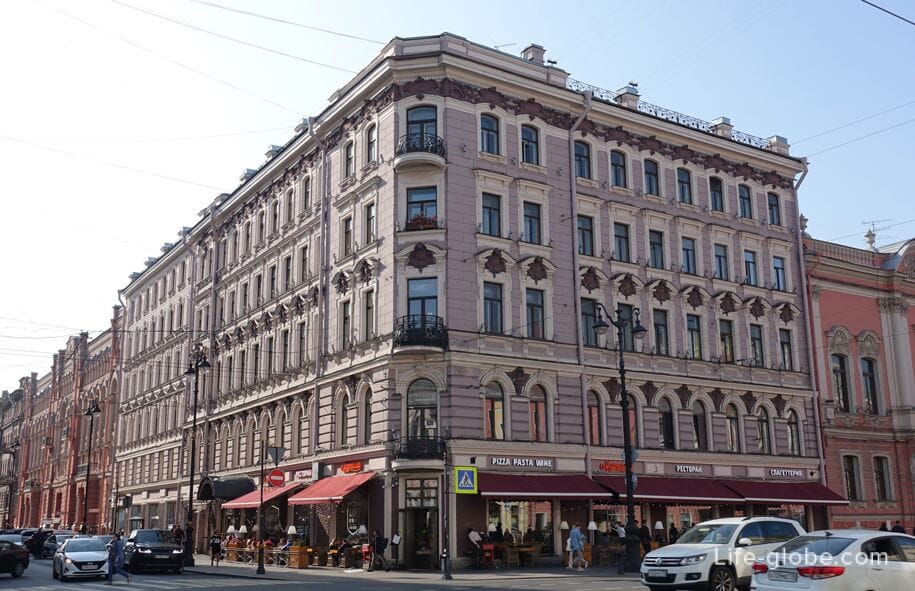
Two elegant houses, with one facade facing Nevsky Prospekt 45 (Rostovtsev House / Filippov house) and 47 (Palkin House), and the other on Rubinstein Street and Vladimirsky Avenue, were originally built for the merchant N. S. Paskov-Sharapov.
Over the course of history, the owners of the houses changed, as well as most of the buildings on Nevsky Prospekt.
The house at number 45 in the 19th century had three floors, was made of stone and belonged to Colonel I. Rostovtsev, then the house housed the Mariinsky Women's Gymnasium. In 1875-1877, the house was rebuilt for the son of Rostovtsev by the architect A. L. Gun-the building was built up to five floors, and the facade was redesigned in an eclectic style. At the beginning of the 20th century, the house belonged to D. I. Filippov, the owner of a chain of St. Petersburg and Moscow bakeries; in the house he opened a confectionery-coffee shop, the interior decoration of which was done by the architect L. A. Ilyin. In 1911, the corner entrance to the building was decorated with a granite portal, now the room is a McDonalds.
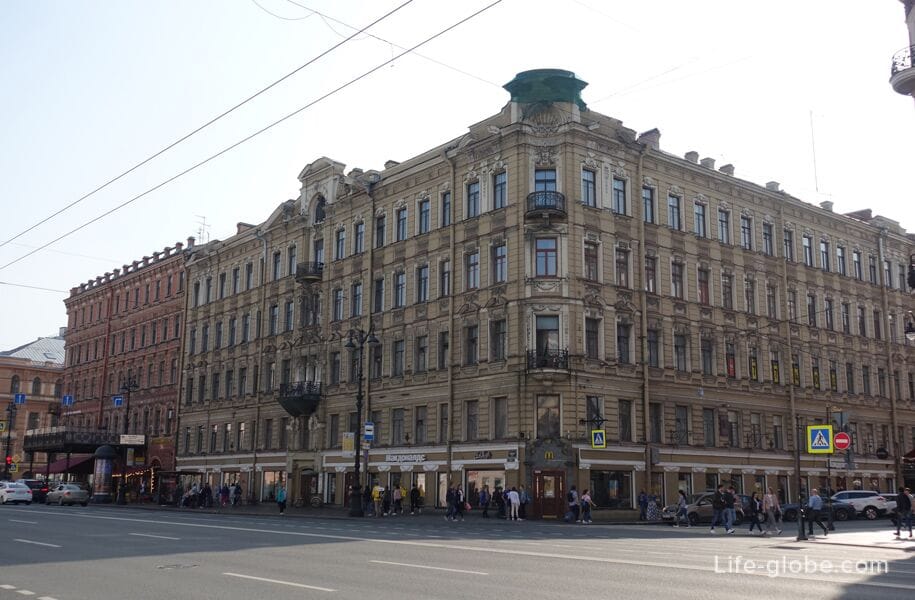

House number 47 the ball was erected in the early 19th century. The building had 2 floors, and was profitable; on the ground floor there were retail premises.
In 1871, the house was bought by the merchant Konstantin Pavlovich Palkin. Three years later, the Palkin restaurant, famous for the best Russian cuisine in the city, moved into the walls of the building. This restaurant attracted wealthy and well-known residents of St. Petersburg. Some of the premises in the building were rented out.
In 1873-1874, the architect A. K. Kreuzer expanded the house and built it up to four floors, and the Palkin restaurant building was built in the courtyard. In 1904-1906, according to the project of A. S. Khrenov, the building was built on the fifth floor. Since 1924, after major repairs, the restaurant's premises began to operate the cinema "Titan", in which, in November 1934, the premiere of the film "Chapaev"took place. In the 1990s, the Palkin restaurant returned to the premises.
The PALKIN restaurant is still located within the walls of the building today.
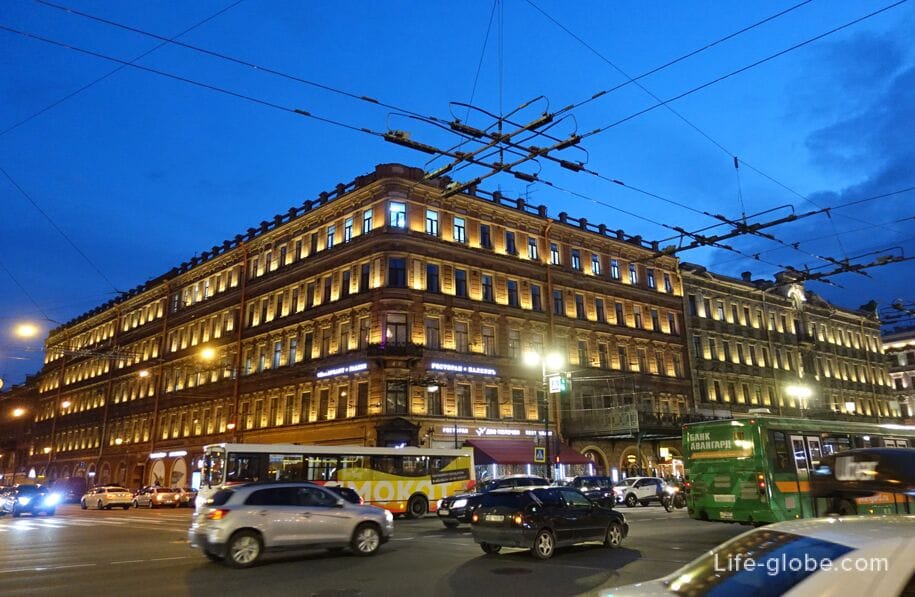
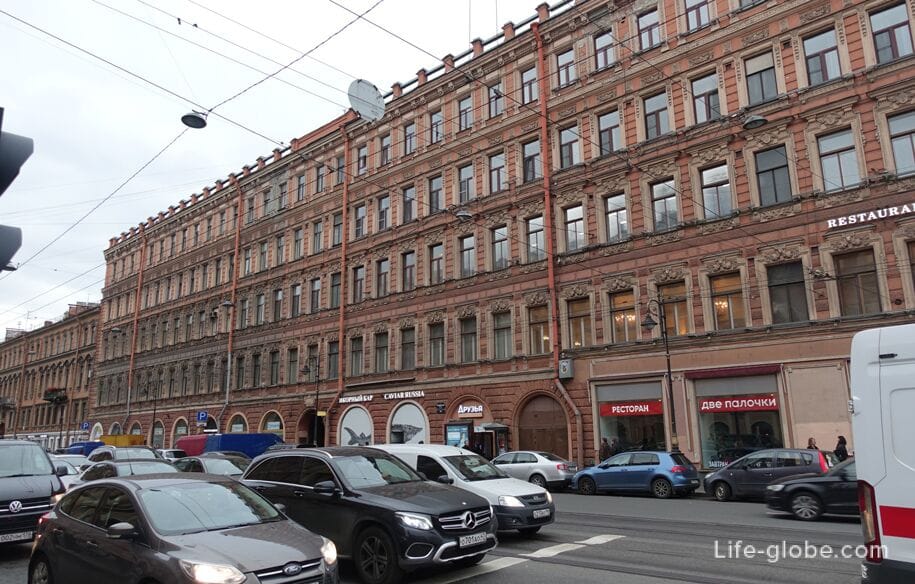
The house at number 70 is the Sukhozanet house (Journalist's house), which was originally built in stone in the early 19th century and had two floors. In the late 1820s, the house passed to the General of Artillery I. O. Sukhozanet. In the 1830s, by order of the general architect D. I. Quadri, the building was re-designed in the classical style. In 1864, the building was bought by the St. Petersburg Merchant Society, for which the reconstruction of the building was carried out according to the project of V. V. Strom - the classical facade was lost and a third-floor balcony was built.
Today, the building has three floors, a strict borderless facade, which is crowned with a pediment; and at the level of the third floor, a balcony still stands out. In the interior of the building, several rooms have been preserved: the lobby, lined with artificial marble, as well as halls decorated with stucco friezes and picturesque plafonds.
The house at number 72 is the house of M. V. Voeikova, which since 1907 belonged to Voeikova. In 1909-1910, the building was radically rebuilt according to the project of civil engineer S. I. Minash, who built a six-story house in the Art Nouveau style. The lower floor was lined with talcochlorite stone, in which stylized images of owls and other birds were carved. In the courtyard, the architect built a two-hall cinema "Master Theater", later renamed "Crystal Palace".
Subsequently, the building changed owners, and various societies and commercial premises were located within its walls.
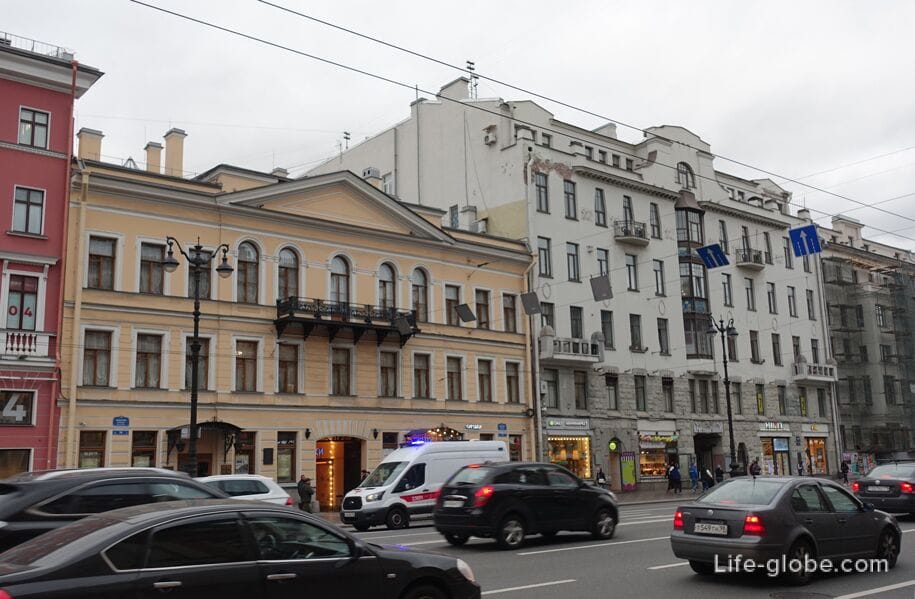
Until the last quarter of the 19th century, the plots of houses numbered 74 and 76 belonged to different owners. In the 1870s, both plots were purchased by the merchant A. L. Kekin, for whom the architect V. M. Nekoram built houses up to five floors, equipped bay windows and balconies.
Subsequently, the buildings changed owners, and commercial premises were located on the first floors and continue to be located. There is also a museum of Magic in the house.
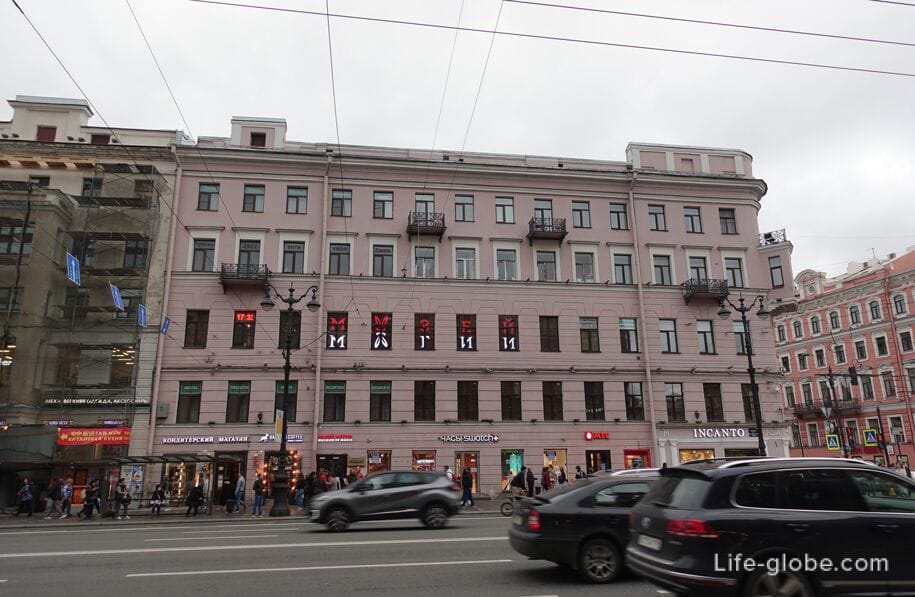
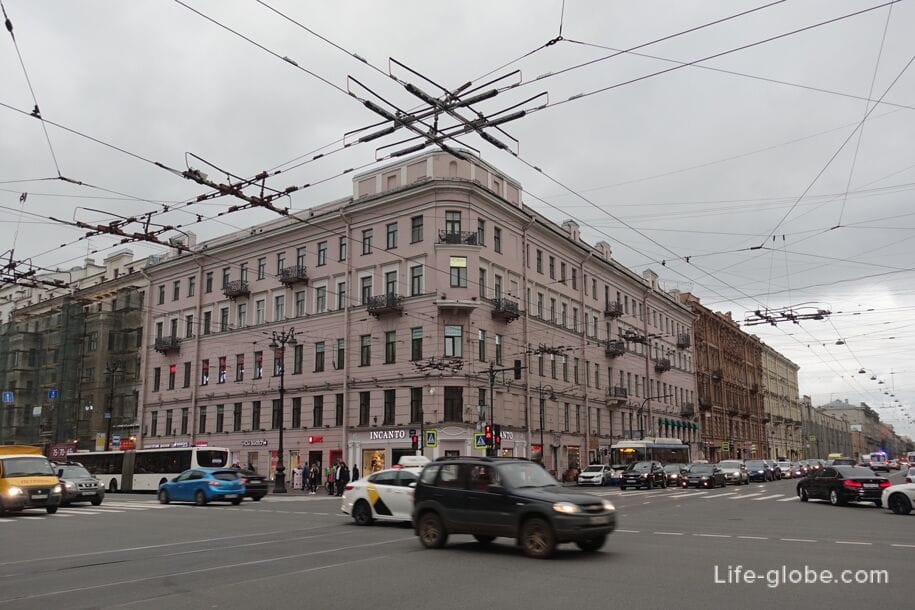
The bright and voluminous corner building at 78 Nevsky Prospekt and Liteyny Prospekt is known as the house of A.M. Tupikov.
The place where the building is located was built up at the end of the 18th century. In 1870, for the hereditary honorary citizen of the merchant A.M. Tupikov, the four-story house located here was rebuilt by the architect E. P. Vargin, who created the facade in the eclectic style. In 1874, according to the project of the architect Yu. O. Dyutel, the house was built on the fifth floor and decorated with arched gables.
In 1870, A. F. Mozhaisky, the builder of the first full - scale aircraft in Russia and one of the first in the world, lived in the house. At the end of the 19th century, a young architect A.V. Shchusev lived in the house.
Subsequently, the house changed owners and it housed various organizations and commercial premises.

The house is also known as the Moscow Hotel.
The first house on the corner of Nevsky and Vladimirsky Avenues was built in the late 18th century. In the 1850s, the merchants of Rotina opened a hotel and restaurant in the building, which became known as"Moscow". In 1880-1881, the architect P. Yu. Syuzor, commissioned by the new owner of the building - merchant A.M. Ushakov, carried out the reconstruction of the four-story building in the eclectic style, including the decoration of the facades with rust chains and stucco details.
A large-scale reconstruction of the building was carried out in 1999-2001. After that, and to this day , the 5-star Radisson Royal Hotel is located within the walls of the building with a fitness center, a spa center with a sauna, a hot tub and a massage room.
The rooms are equipped with: a Nespresso coffee machine and tea/coffee making facilities, a high-definition TV with Smart TV technology, as well as a One Touch button for quick access to hotel services. There is also a bathroom with underfloor heating.
A buffet breakfast or an American breakfast can be included in the room rate. Children under 5 years old can enjoy breakfast free of charge. Link to the hotel
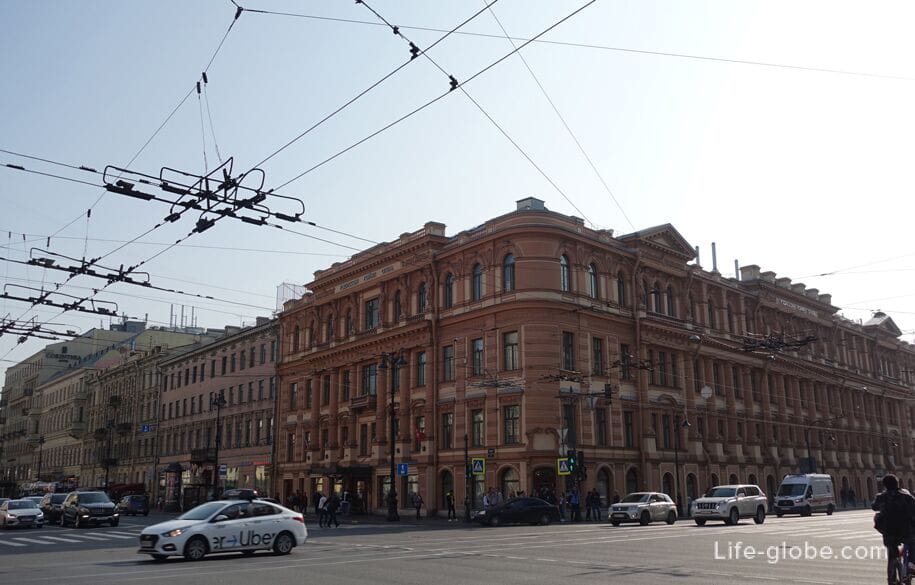
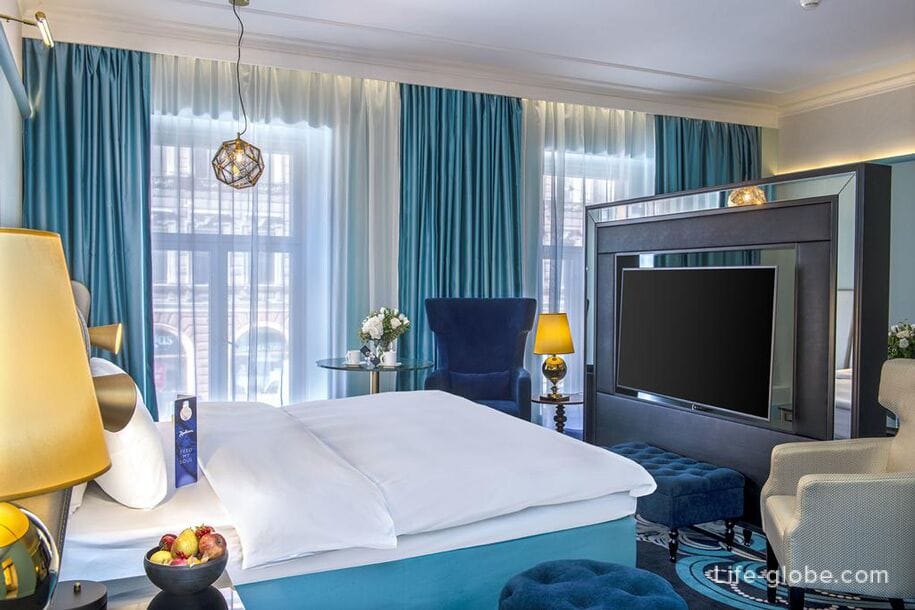
Under the numbers 80 and 82 on Nevsky Prospekt, there are architecturally and in height different buildings.
Nevsky Prospekt 80 - the house of N. I. Dernov, also known as the house of L. V. Lipgart or the Parisian cinema.
The house on this plot was built in the 1800s, when a three-story house of the merchant Gavrila Panin appeared here.
Subsequently, the house changed owners. The owner of the plot, the Narva burgher merchant A.V. Lipgart, carried out the reconstruction of the building in 1872-1873 according to the project of the architect M. A. Makarov. The next reconstruction of the building was carried out in 1913-1914 by the architect M. S. Lyalevich. During the alterations, the facade of the building was decorated in the neoclassical style and divided into two tiers: the lower part of the building is decorated with an elegant arcade with glass windows, and the upper part is decorated with a few sculptures and small decor. The number of storeys of the building was also increased - the fifth and sixth (attic) floors were added. In the courtyard there was an outbuilding designed for the cinema "Parisiana" (in the 1919-1990-ies known as the cinema "October").
In the early 1990s, the interior of the building was rebuilt by architect T. M. Hasanov.
Nevsky Prospekt 82 - the house of E. A. Brun.
The building was built by engineer-Major E. A. Brun in 1834. Subsequently, the building changed owners and various societies and commercial premises were located within its walls, including the literary society "Arzamas".
In the middle of the 19th century, the building was owned by Lieutenant General I. K. Maksimovich. In 1852, the architect N. P. Grebenka redesigned the second floor, arranging a bay window in the center of the facade, which can still be seen today. In 1859, a U-shaped wing was built in the courtyard of the house by the architect E. I. Winterhalter.
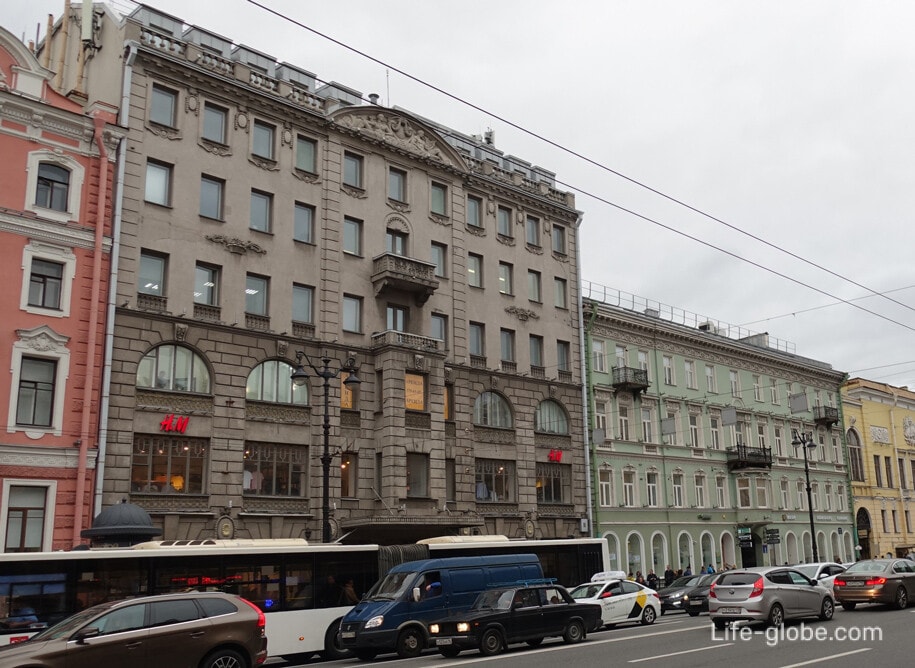
The building is also known as the Actor's House (or the Benardaki house, or the Yusupov House), and is one of the most beautiful buildings on this section of Nevsky Prospekt.
In the middle of the 18th century, the chief prosecutor of the Senate, Prince N. Y. Trubetskoy, built a manor house with a wooden mansion on this site. In the 1780s, his son, Senator P. N. Trubetskoy, built a three-story stone house on the site.
By 1820, the house was rebuilt by the architect M. A. Ovsyannikov for the owner - Colonel F. N. Petrovo-Solovovo. Then the building acquired the existing classical appearance with a six-column portico in the middle.
In 1835, for Count Branicki, the building was designed by G. Fossati and added side wings and enriched with decor on the facades. Concerts and exhibitions were held in the Branicki mansion.
In the 1840s, the house was owned by Kalugin. Later, it was owned by a Greek, lieutenant and rich winemaker Dmitry Yegorovich Benardaki, who had a garden with a gazebo-stage in the courtyard of the house and built residential buildings in the depth of the plot.
By 1877, the house was purchased by the chamberlain Prince N. B. Yusupov, who began to use it as a room for exhibitions and social receptions. At the beginning of the 20th century, the cinema "Electrotheater" ("Pathe") was opened in the walls of the building, and in 1907 - the museum-panopticon of wax figures.
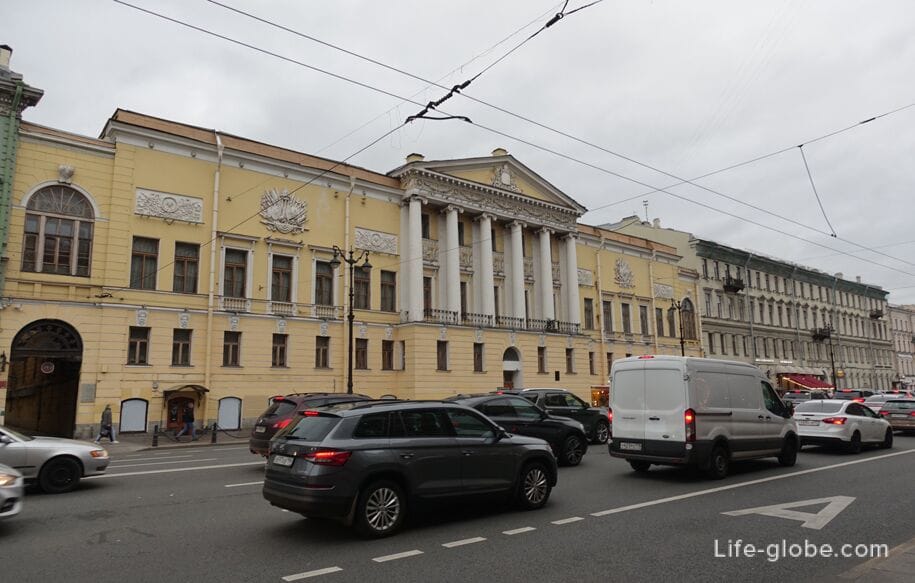
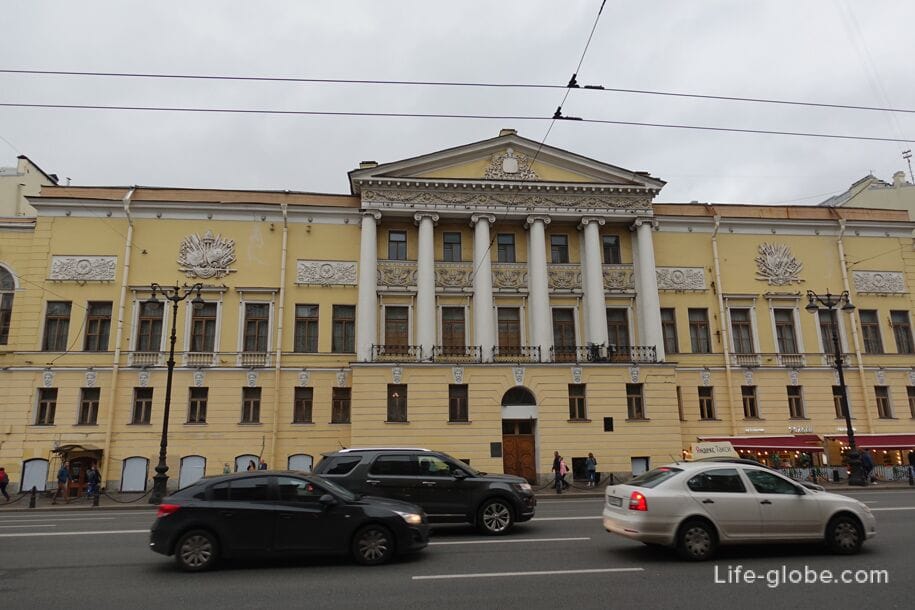
At the end of the 18th century, two small houses stood on this site. In the second quarter of the 19th century, a four-story stone house was built for the merchants Menyaev. In 1910-1911, architect A. S. Khrenov commissioned O. P. Kusheleva to build courtyard buildings.
Subsequently, the house was occupied by: a publishing house, a printing house, a literary society and Higher Women's Natural Science Courses, and in the courtyard building there was a cinema "Union" ("Vitograph").
In the post-war years, the cinema, then called "Chronicle", "News of the Day" showed documentaries, newsreels. In 1980, it began showing 3D films. Then the cinema was renamed "Stereokino".
Currently, the first floor of the building is occupied by cafes and shops.
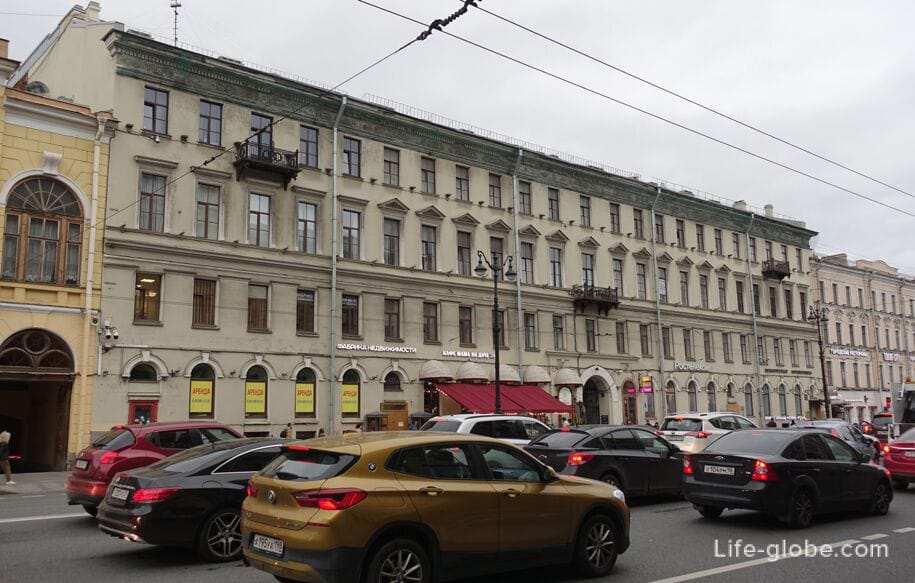
The scheme of development on this site was formed at the turn of the 18th and 19th centuries, when there were two three-story stone houses separated by a passage to the central wooden mansion.
In the first half of the 19th century, the merchant P. Menyaev owned the plot. For S.P. Menyaev in 1866-1867 by architect A.K. Bruni, the left house (No. 90) was built on the fourth floor, as well as the design of the facade of the building was changed and the courtyard wings were attached.
The central four-storey house, which is located in the depth of the plot-between houses 90 and 92, with a facade in the neo-Baroque style, was built for K. S. Menyaev in 1898-1899 by the architect V. A. Schroeter.
In 1903, architect A. P. Shiltsov began the expansion and reconstruction of house No. 92 for K. S. Menyaev. His work was completed in 1904 by A. M. Kochetov.
Currently, all three buildings are a diverse architectural ensemble, which is connected by a single history.
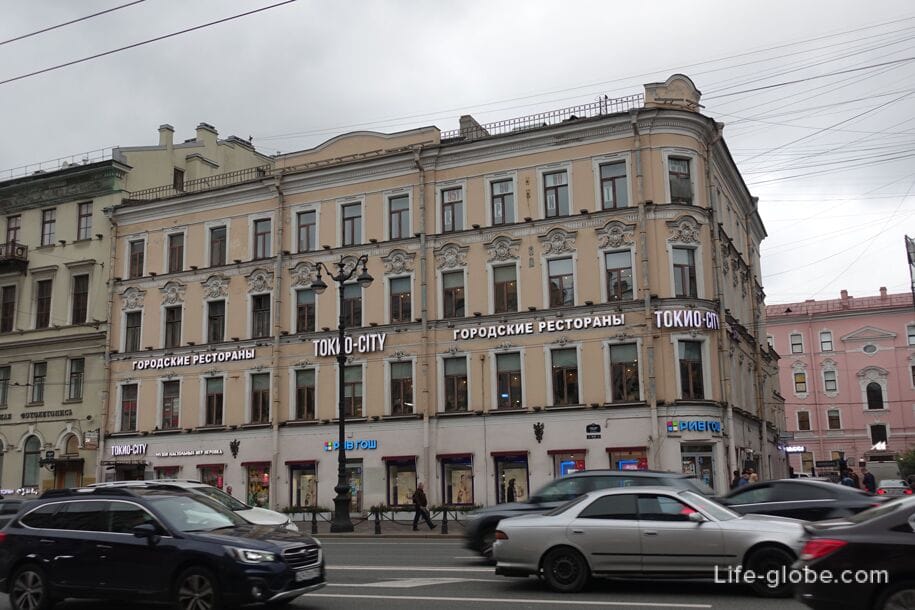
At the numbers 51, 53, 55, 57, 59 and 61 on Nevsky Prospekt, not particularly attractive, but also significant buildings are lined up in a row, the history of which dates back to the 19th century.
The building at number 51 is the Kozhevnikov House, which was built in 1834-1835 for the guards of Lieutenant Kozhevnikov. Architect P. F. Votsky erected a building with a classical facade, which has survived almost unchanged to our time.
The building at number 53 is the house of merchant A. G. Chadaev, for whom in 1882 the three-story house already standing on this place was rebuilt by the technician M. A. Andreev, who added the fourth floor and changed the facade. In the 1900s, the windows of the basement rooms were decorated in the Art Nouveau style.
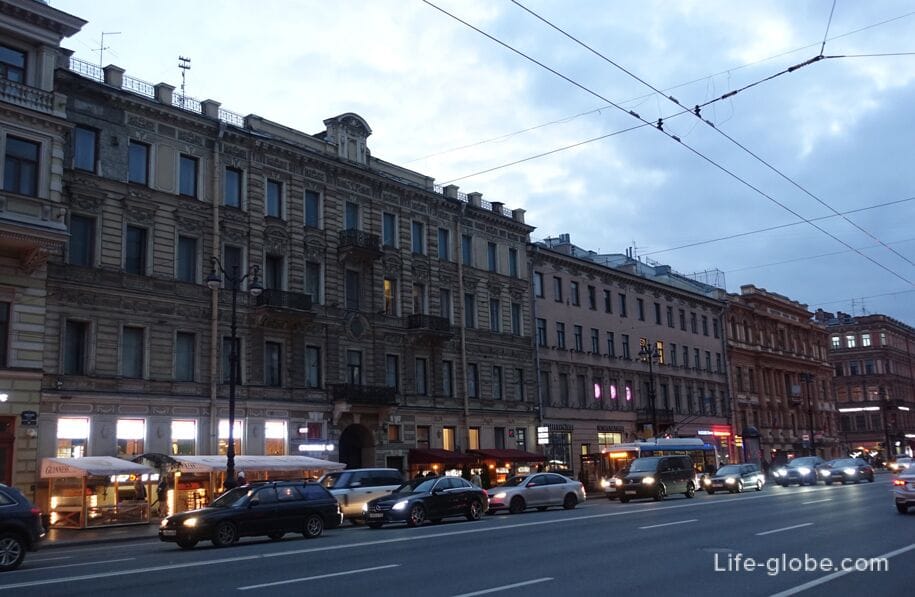
The building at number 55 is the house of merchant A. N. Tryanichev, for whom in 1892 the existing three-story building was rebuilt in the eclectic style by architect A.V. Ivanov. The building has four floors and an attic, side bay windows and a central balcony at the second floor level. Today it is a business center "Nevsky Plaza".
Building number 57-the house of the Tsarevich Nicholas Vocational School (hotel "Nevsky Palace"). This building was built and modified over time. Today, it stands out noticeably among the surrounding buildings for its size.
After 1917, hotels operated in the house. In the 1990s, the hotel complex was radically rebuilt and a five-star hotel "Nevsky Palace"was opened in the building.
Today, the 5-star Corinthia St. Petersburg Hotel offers spacious, elegant rooms, a restaurant, a bar, free Wi-Fi, a sauna and a gym. Breakfast can be included in the room rate. Link to the hotel
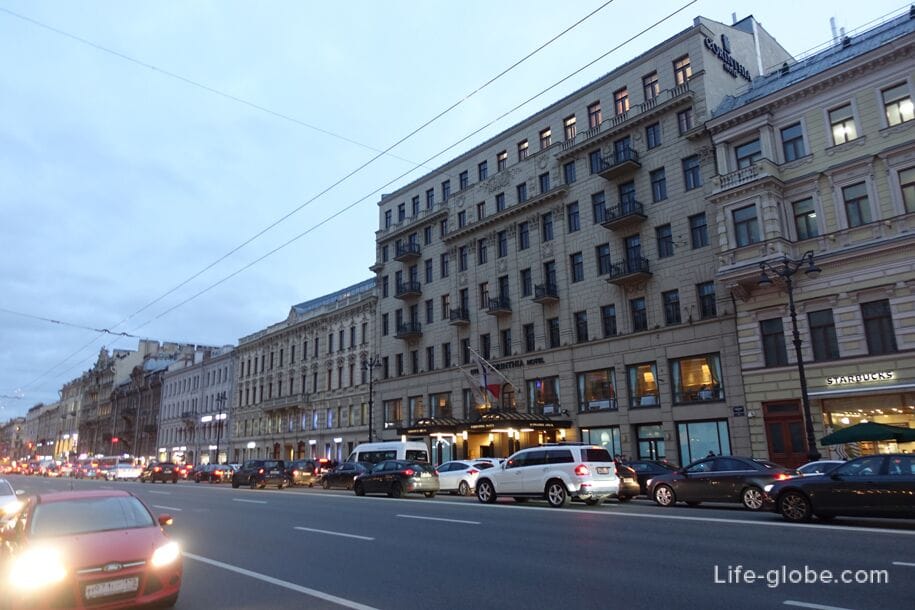
The building at number 59 is the house of Yu. A. Voeykova (Commission of Theological Schools), which at the beginning of the 19th century belonged to the Commission of Theological Schools. The building was subsequently rebuilt. In 1873-1874, for Yu. A. Voeykova, the facade of the house was changed by the architect K. I. Reimers, and the building received an eclectic appearance.

The building at number 61 is the I. L. Loginov house, which was built in 1849 for the merchant, carriage master I. L. Loginov. The author of the project was the architect A. H. Pel, who executed the facade of the building in the style of early eclecticism. Subsequently, the appearance of the house changed slightly. The third and fourth floors of the building are connected by shovels.
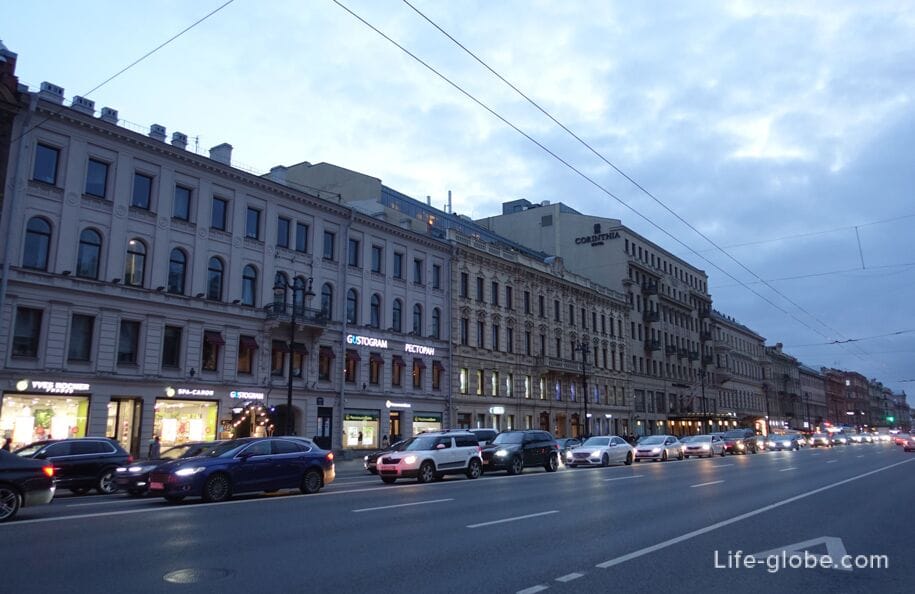
On Nevsky Prospekt 63 there is a magnificent house, from which it is difficult to tear your eyes away.
The original building on this site was built in the late 18th and early 19th centuries and had two floors. Until 1854, the building was owned by the State Councilor, the president of the Medical and Surgical Academy, J. V. Willie. In the 1860s, the building passed to a new owner - his wife V. I. Willie, who in the 1870s also owned the neighboring house at number 65. It should be noted that in terms of sophistication and architectural appearance, house No. 65 is in no way inferior to this house at number 63.
In 1872, the house No. 63 was purchased by the court councilor I. F. Alexandrovsky, for whom in 1875-1876 the architect P. Yu. Syuzor built the courtyard wings; and after that, the same architect built the main building with the third and fourth floors and decorated the facade in the eclectic style. The mezzanine with a dome was supposed to remind of the Parisian architecture of the 17th and 18th centuries. The putti figures on the mezzanine have a special charm.
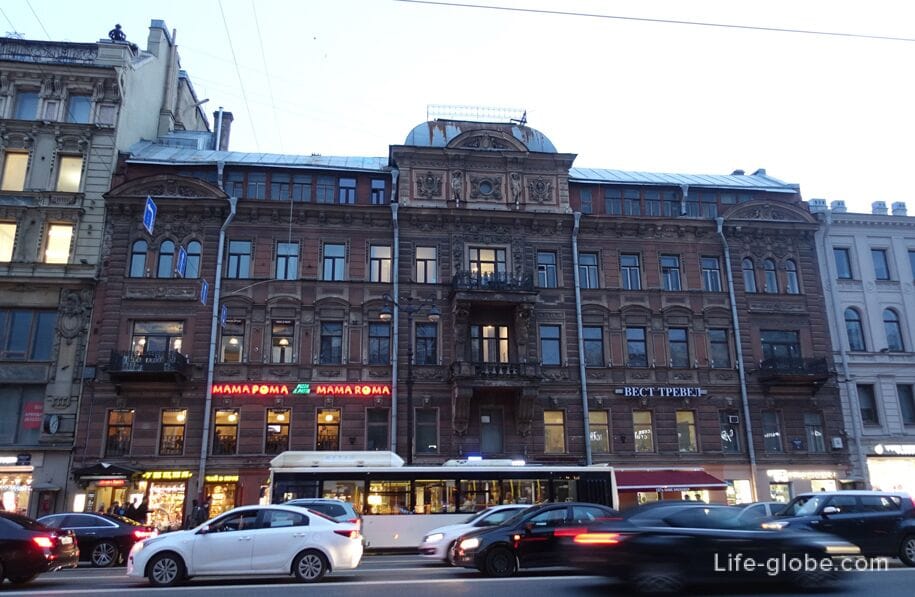
The house on this site has existed since the 1820s and has changed several owners.
In 1902-1904, a new building was built on this site for the Turkish citizen banker G. G. Blokka. The author of the project was the architect L. L. Fufaevsky, who included the walls of the old house in the new structure. The facade of the building was decorated in an eclectic style.
Subsequently, the building changed owners, and its premises were used for various purposes.
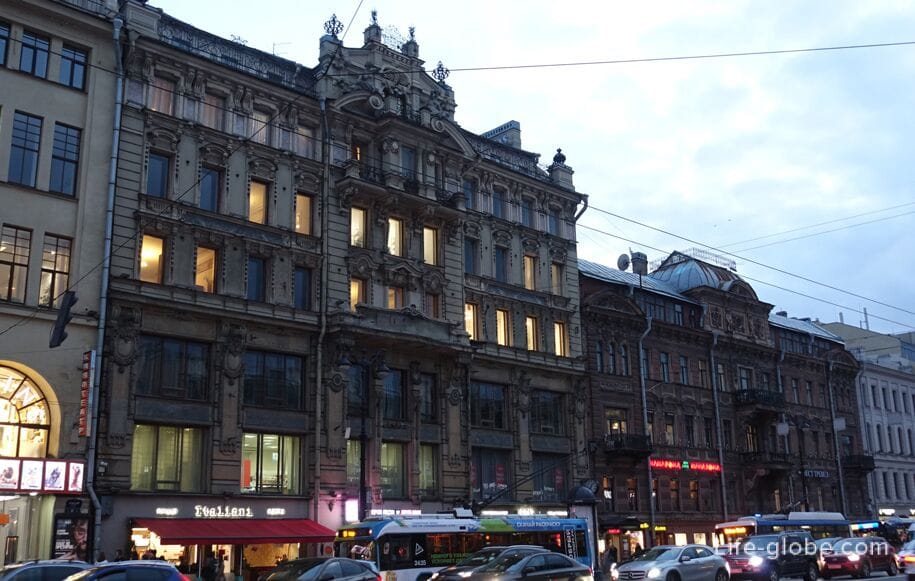
The houses numbered 67, 69, 70 were built in the 19th century and now have similar architectural features.
The building at number 67-the house of N. V. Tchaikovsky was built in 1842 by the architect R. I. Kuzmin for the wife of the merchant Strom and had four floors. Later, the building was owned by: the actual state Councilor N. A. Bezobrazov, Prince Khovansky and hereditary honorary citizen A. S. Wagenheim, under whom the architect V. V. Windelbandt the house was built up to five floors.
In 1911, the owner of the house was Captain 1st rank N. V. Tchaikovsky, who opened the Saturn cinema in the building. In 1915-1920, the building was radically rebuilt according to the project of architects I. P. Volodin, V. I. Shene and A. A. Maksimov.
The building at number 69 is the Yakovlev House, which from the first quarter of the 19th century until 1917 belonged to the Yakovlev merchant dynasty. In 1822, a three-story house was built for D. and T. Yakovlev, designed by architect Sokolov. In 1851, for I. T. Yakovlev, the architect V. V. Strom built the building on the fourth floor.
Today, the 4-star Nevsky Forum Hotel is located within the walls of the building, offering free Wi-Fi, a restaurant and a bar. The air-conditioned rooms are decorated in warm colours and feature a flat-screen TV with satellite channels, a minibar and a bathroom with free toiletries, slippers and a hairdryer. Breakfast can be included in the room rate. Link to the hotel
The building number 71 is the house of P. I. Zaitsev, which was built in 1848 for the merchant P. I. Zaitsev according to the project of P. A. Chepyzhnikov. Today, the building houses commercial premises and the Nevsky Atrium shopping center. The building also houses the lobby of the Mayakovskaya metro station.
This corner building is located at 71 Nevsky Prospekt and Marat Street.

Photo of Marat street
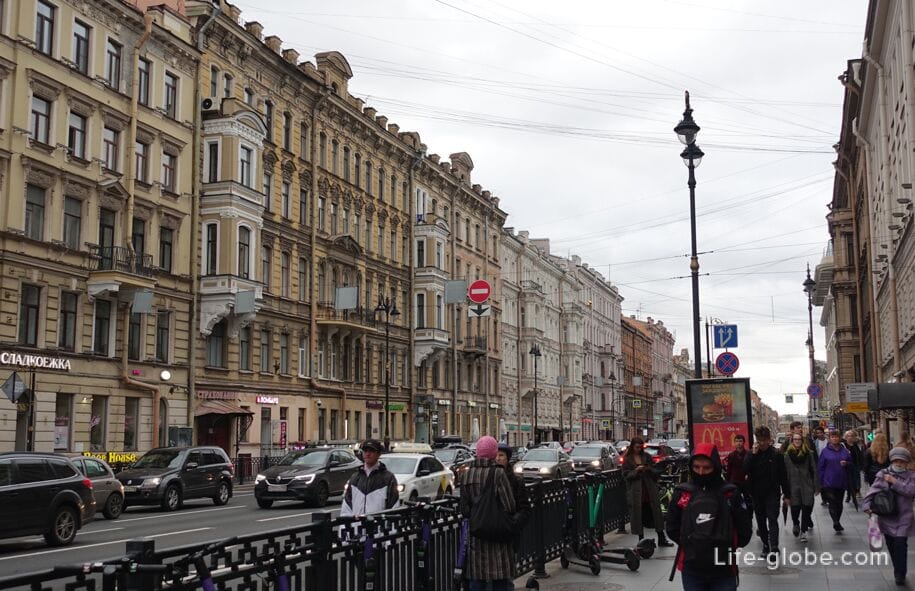
The Yakovlev House is a corner building at 96 Nevsky Prospekt and Mayakovsky Street.
The three-storey house was built for the adviser of the State Military College V. A. Pashkov by 1798.
At the beginning of the 19th century, the house was purchased by the Yakovlev family of merchants. In 1838 or 1839, for I. T. Yakovlev, the architect A. H. Pel added a fourth floor to the building and erected two courtyard wings.
In 1871, Makarov rebuilt the building, while richly decorating its facade, which became saturated with stucco eclectic decorations. In addition to the rich decorations, the building stands out with a wide risalit with rounded corners and a mezzanine with putti figures.

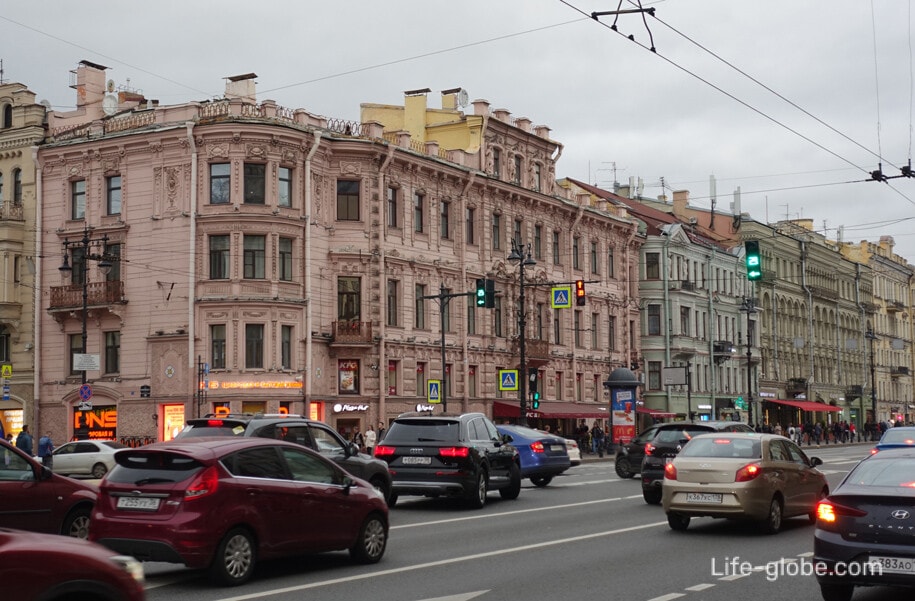
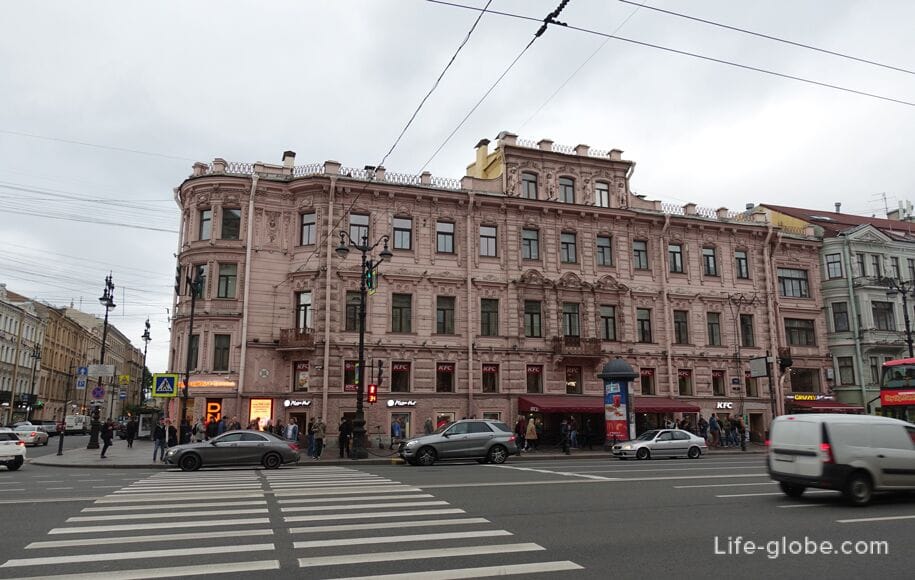
The following buildings on Nevsky Prospekt are numbered 98, 100, 102, 104, 106, 108, 110 and 112 have striking facades, and, perhaps, are the most attractive part of this section of the avenue.
The building at number 98 is the Lopatin House, which was built in the first half of the 19th century for the Lopatin merchant family. The house had three floors.
In 1868, the architect M.A. Makarov built the building on the fourth floor and gave the facade features of the classicism style. In the 1910s, the first Russian athletic "Hercules Club" was opened in the building.
In 2003, the house was reconstructed, as a result of which an attic floor was built on it. The first floor of the building is occupied by commercial premises.
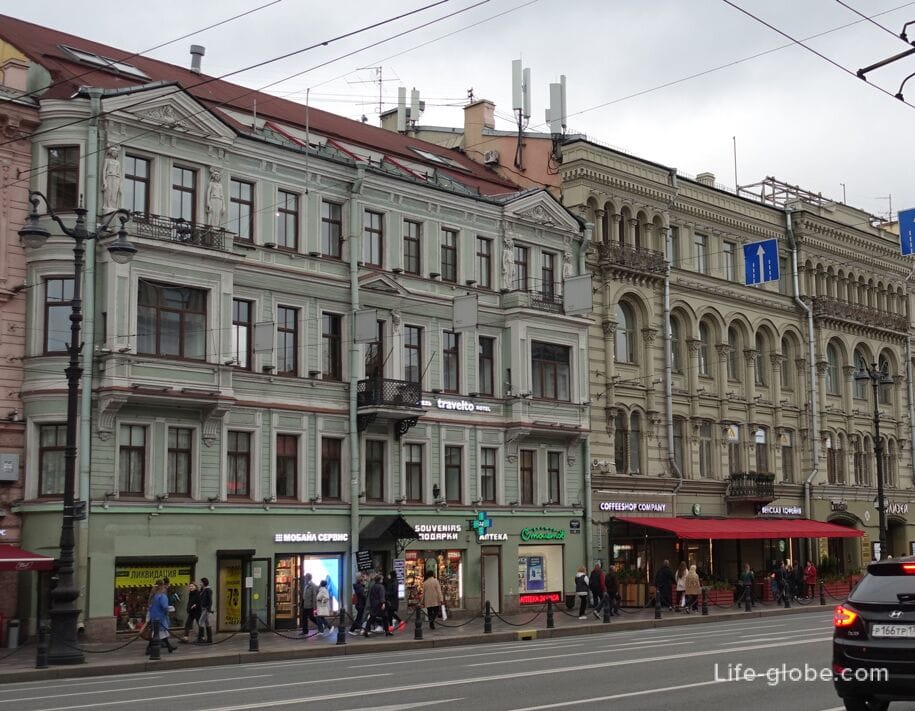
The building number 100 is the house of M. I. Lopatin, which was built in 1866-1867 for the merchant of the 1st guild M. I. Lopatin, designed by architect M. A. Makarov. The house had four floors and was built on the site of the previous two-story building with an open shopping arcade on the first floor.
Subsequently, the building changed owners and various establishments opened in it, including a restaurant, cafe and cinema "Colosseum". Today, the walls of the building, including a concert hall with the historical name "Colosseum".
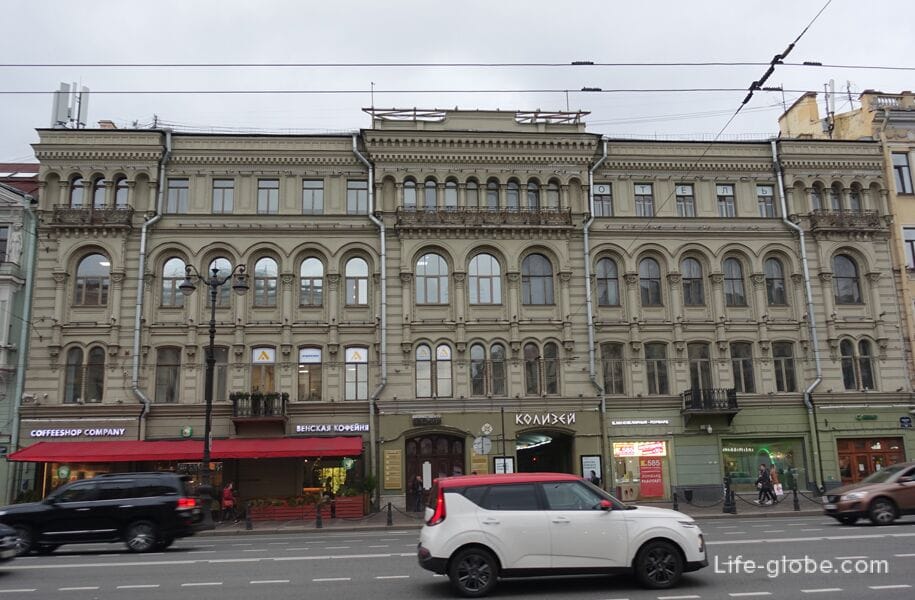
Building number 102 is the house of the Serpents, which originally had two floors and was erected by the beginning of the 19th century. In the 1830s, the building was added to the third floor. In the 1840s, the merchant Vikulov was the owner of the house, and in the 1850s, the Friedrichsgam merchant F. Snakes.
In 1877, for the hereditary honorary citizen V.F. Zmeev, the architect I.I. Bulanov built a new residential four-story house on this site. From the end of the 19th century until 1917, the plot belonged to the son of V.F. Zmeev - N.V. Zmeev. In 1898-1899, his brother, the landlord, civil engineer Ya.V. Zmeev, arranged a two-tier trading hall in the house and built yard wings.
The fifth floor of the building was built by architect A.S. Khrenov in 1908.
Building number 104 - the house of A.I. Gruzdev.
At the beginning of the 19th century, there was a two-story stone house on this site. In 1828, the architect A.Z. Komarov built it on the third floor for the merchant's wife V. V. Frolova. Later, the plot passed to the merchant Neslind.
In 1877, the architect I.I. Grigoriev built the house on the fourth floor for the wife of Major General E.S. Shcherbatova. At the turn of the 19th and 20th centuries, the building was acquired by the hereditary honorary citizen A.I. Gruzdev, for whom in 1902 the architect N.A. Melnikov, breaking the previous structure, built up the courtyard, and in 1903 built a new four-story front house.
Today, in the walls of the building, including, is located Interior Theater, founded on July 8, 1988.
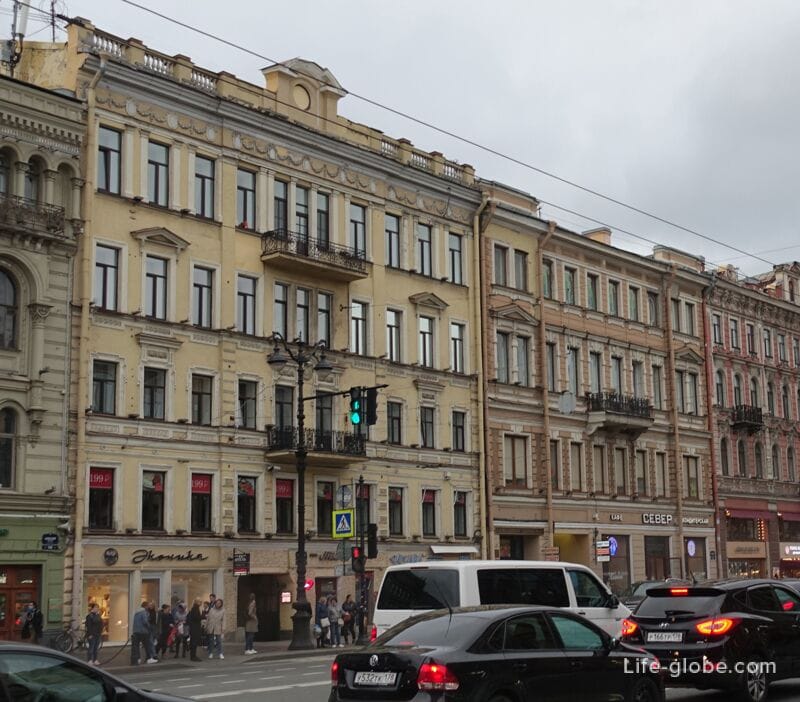
Building number 106 - the house of A.E. Shlyakov.
Initially, this place was a two-story stone house. In 1837, the architect A.I. Melnikov built it on the third floor and built courtyard wings. The customer of this work was the merchant's wife A. Durdin.
In 1873-1874, for the merchant A.E. Shlyakov, the architect V. M. Nekora added two more floors to the house and redesigned the facade in the eclectic style.
In 1913, the architect A.G. fon Bock converted the left windows of the first two floors into wide showcases, the piers between which were faced with granite.
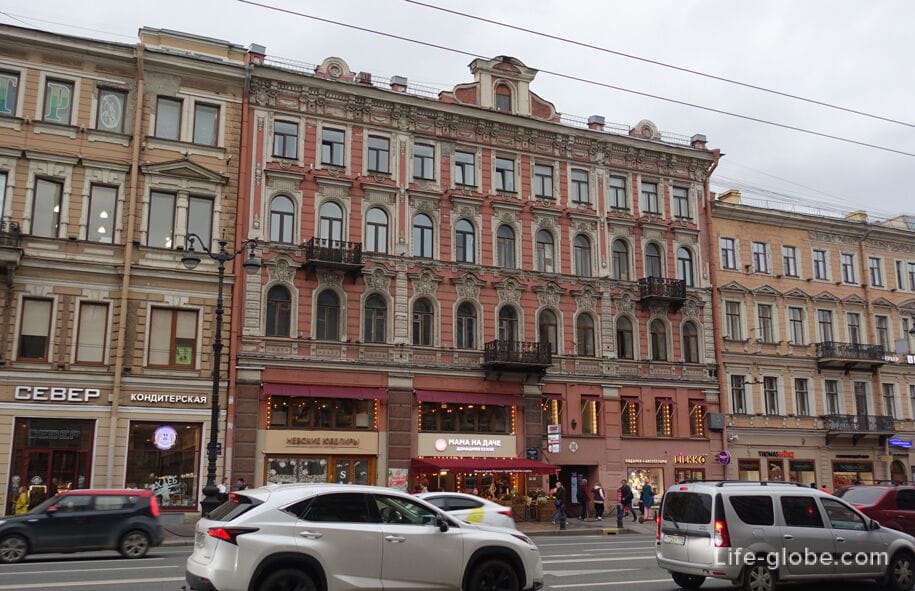
The building at number 108 is the house of merchant P.O. Ivanov, for which in 1862 the architect A.I. Lange built a three-story house that already exists on this site, with the fourth floor and expanded the space at the expense of the courtyard wings.
Later, the house changed hands. In 1913-1914, the architect V.S. Karpovich built a two-tier cinema building in the courtyard of the house - now it is the Neva cinema.
Building number 110-the house of the Zmeevs, which was built in the early 19th century, had four floors and belonged to the merchants of the Zmeevs. In 1879, the architect I.I. Grigoriev rebuilt the house and gave its facade an eclectic appearance.
The building at number 112 - the Yakovlev House, which appeared on this site in the early 19th century, had three floors and belonged to the Yakovlev merchants. In 1866, for P.D. Yakovlev, the architect M.A. Makarov built the fourth floor on the house and replaced the classical facade with a richly decorated facade in the eclectic style. The Yakovlev family owned the building until 1917.
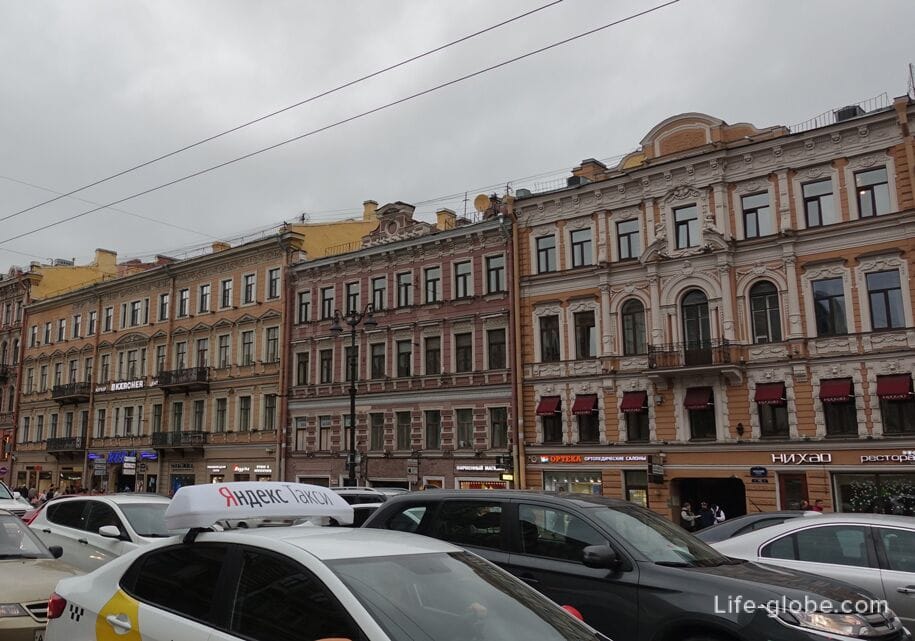
At the address: Nevsky Prospekt, 114-116, now there is a building with a recreated historical facade, within the walls of which there is a large shopping complex "Nevsky Center".
Initially, on the site of the current shopping complex, there were two houses built in the early 19th century and owned, among others, by the merchant Semyanov (house 114) and the hereditary honorary citizen, merchant of the 2nd guild D.A. Durdin (house 116).
In 2006, the buildings were destroyed, and a shopping center was "born" in their place.

The house of H.A. Tipner is a corner building and is located on the corner of Nevsky Prospekt 73-75 and Marat Street.
In the first half of the 19th century, there were two-story Baroque houses on the site, which belonged to the apothecary Tipner. In 1834-1838, the architect L. A. Staufelberger built a new four-story building on the site of the corner house No. 73. In the same period, a three-story house was built at number 75.
Subsequently, the houses changed owners.
At the end of the 19th century, both houses were again owned by the same owner - the Wolfson family. In the 1900s, State Councilor B.P. Wulfson became the owner; then-merchant of the 1st guild D.V. Bykhovsky. In 1901, the civil engineer A.I. Nosalevich built the house at number 73 on the fifth floor and slightly changed the facade of the entire building. In 1903 and 1914, ground-floor display windows were constructed.
House No. 75 was built after the war and its facade acquired neoclassical features. In the 1970s, both houses underwent major renovations.
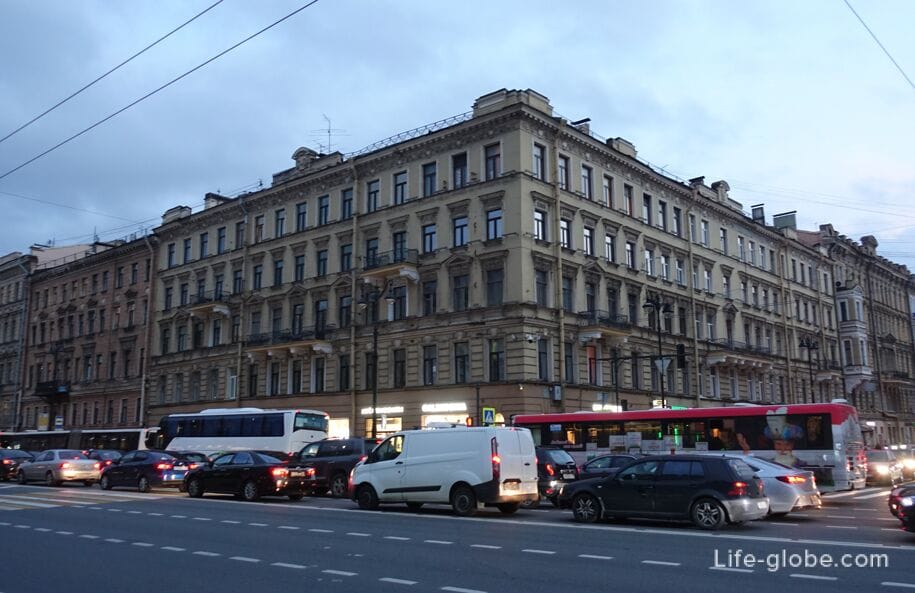
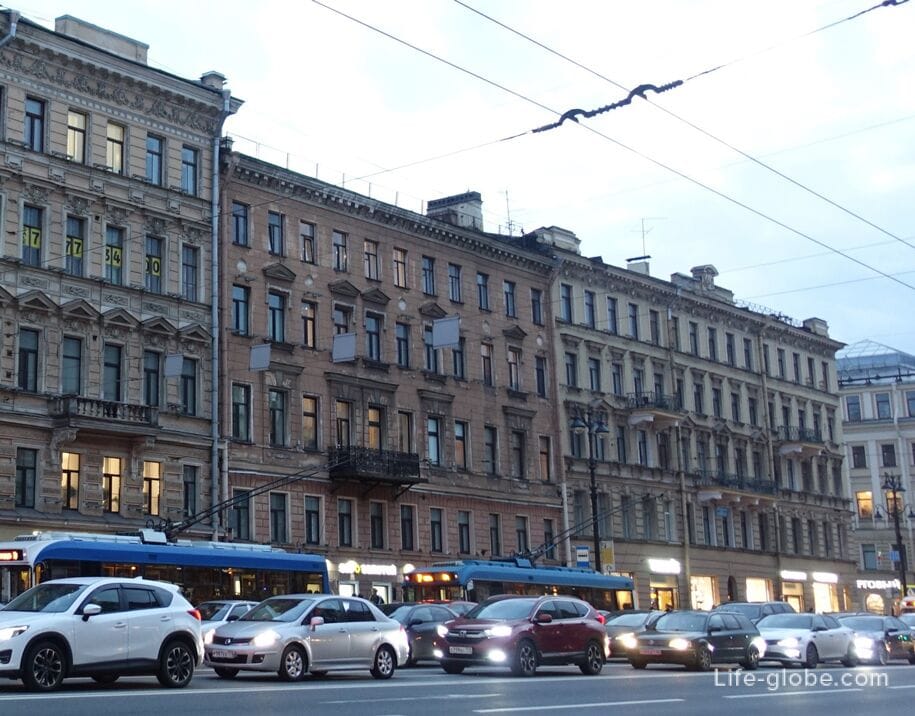
These corner houses of the same type are located on Nevsky Prospekt 77 and 79 and are separated by Pushkinskaya Street.
In the first half of the 19th century, the plot belonged to the merchant Lopatin.
Since 1874, both corner houses have been acquired by the Maltsev family. House No. 79 belonged to titular adviser P.D. Maltsev, and house No. 77 belonged to his wife M.S. Maltseva. For the owners, architect P.Y. Suzor built symmetrical apartment buildings that included the walls of old buildings.
In 1876, baths were opened in the house No. 77 on Nevsky Prospekt (they worked until the 1960s). From the Maltsevs, both sections passed to Adjutant General P.A. Shuvalov, and in 1908 to his son A. P. Shuvalov.
Photo of house No. 77
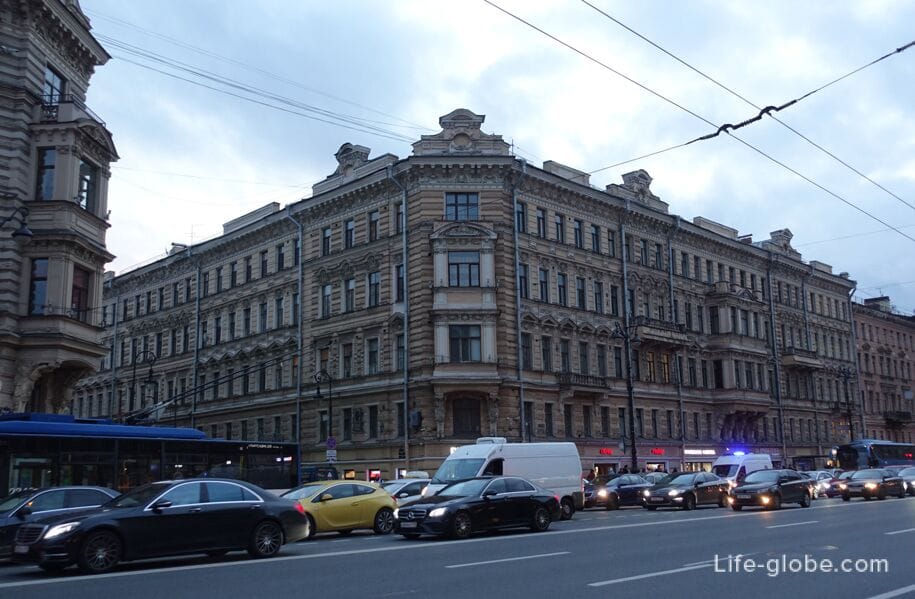
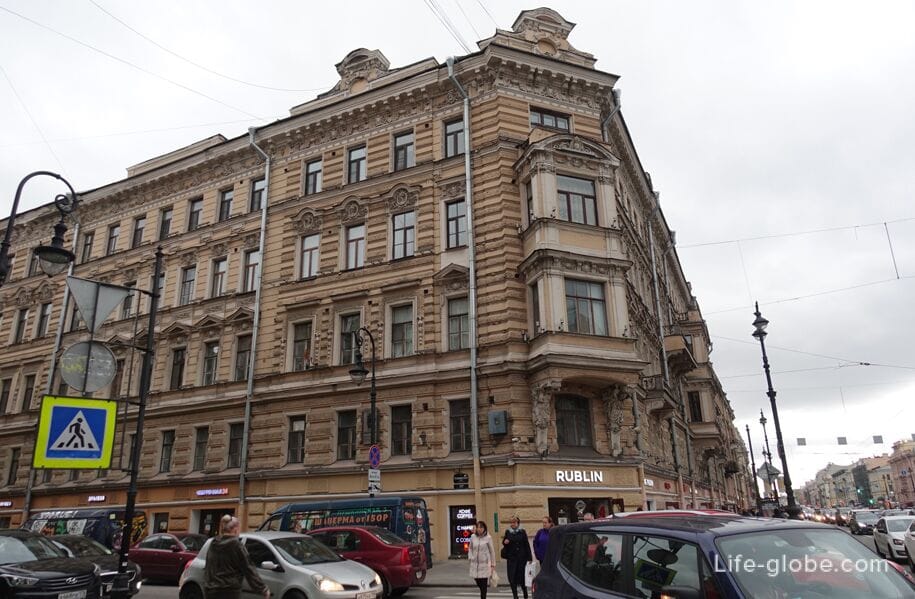
Photo of house No. 79
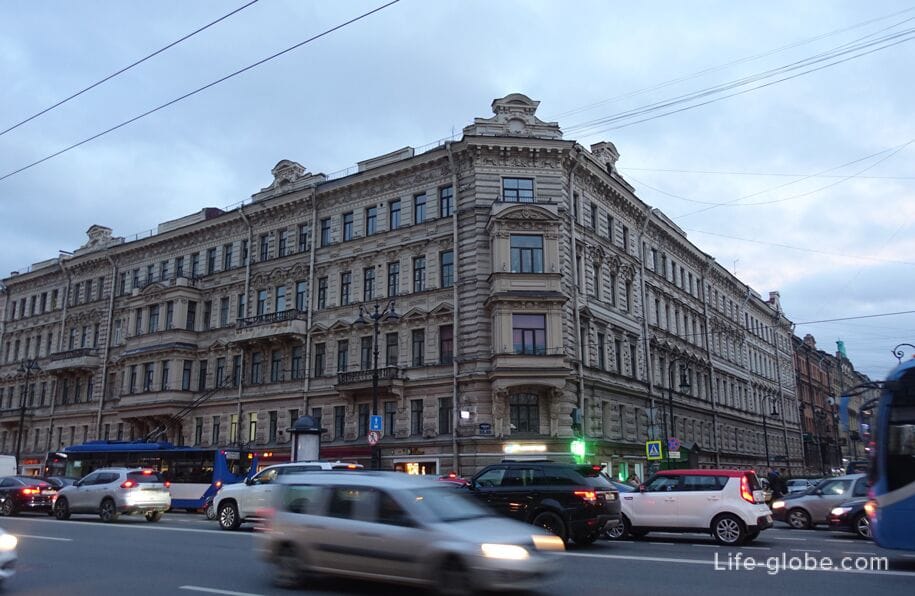


Pushkinskaya Street
Pushkin Street, which separates the two above-mentioned houses, is also one of the beautiful streets of St. Petersburg with monumental historical buildings.
The street was founded in 1874 and since 1881 was and still is called Pushkinskaya.

In the first half of the 19th century, the plot of the house belonged to a middle-class woman V. D. Pershina.
In 1851-1852, the architect A.P. Gemilian built a four-story house for the hereditary honorary citizen A. Timofeev. In the 1900s, it was owned by civil engineer K.K. Kohenderfer, then S.A. Ugryumova and F.F. Ugryumov. For the Ugryumovs, in 1910-1911, civil engineer N.L. Zakharov built courtyard wings.
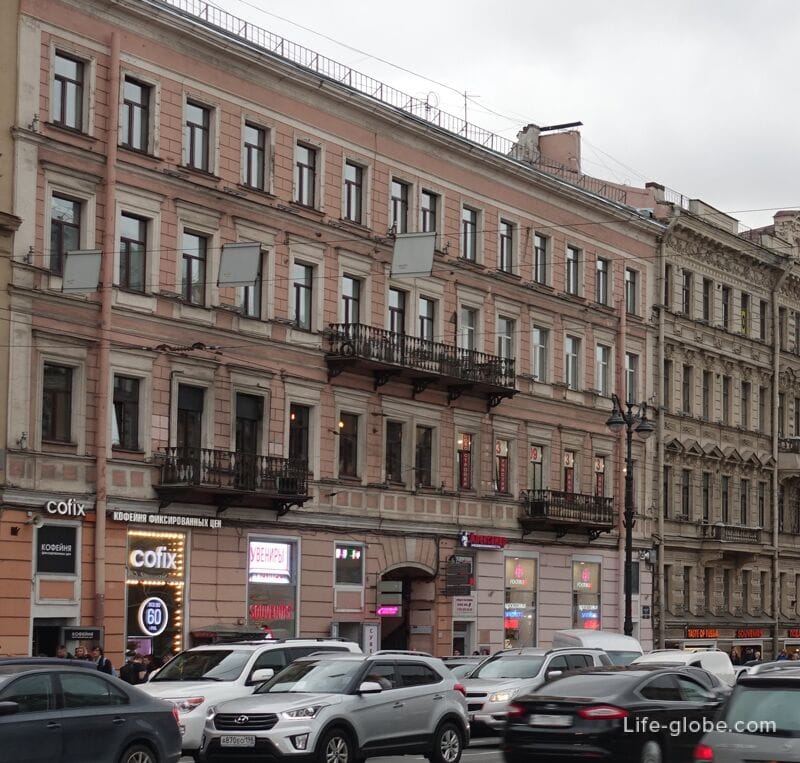
The house on this site was built in 1843 by architect A.S. Andreev and had three floors. The customer was the wife of the Guard Colonel Sh.A. Markevich.
In 1881-1883, by order of the merchant of the 1st guild, hereditary honorary citizen F.I. Korovin, architect A.V. Ivanov built the house up to five floors. The facade created at that time has survived to our time with some loss of decor. In 1883, the plot became the property of A. F. Korovin, and in the early 20th century-the widow of the hereditary honorary citizen A. A. Korovina.
In May 1891 and in January 1894, V.I. Lenin lived in the furnished rooms of the house.
In 1904, part of the building on the side of Ligovsky Prospekt was dismantled, and in its place, civil engineer G.S. Gavrilov built a new four-story building.
Vosstaniya Square is one of the central and most famous squares in St. Petersburg.
The center of the square is decorated with a high obelisk "To the Hero City of Leningrad", and along the perimeter there are historical buildings, including the ground pavilion of the same name of the metro station and Moskovsky railway station. Learn more about Vosstaniya Square…
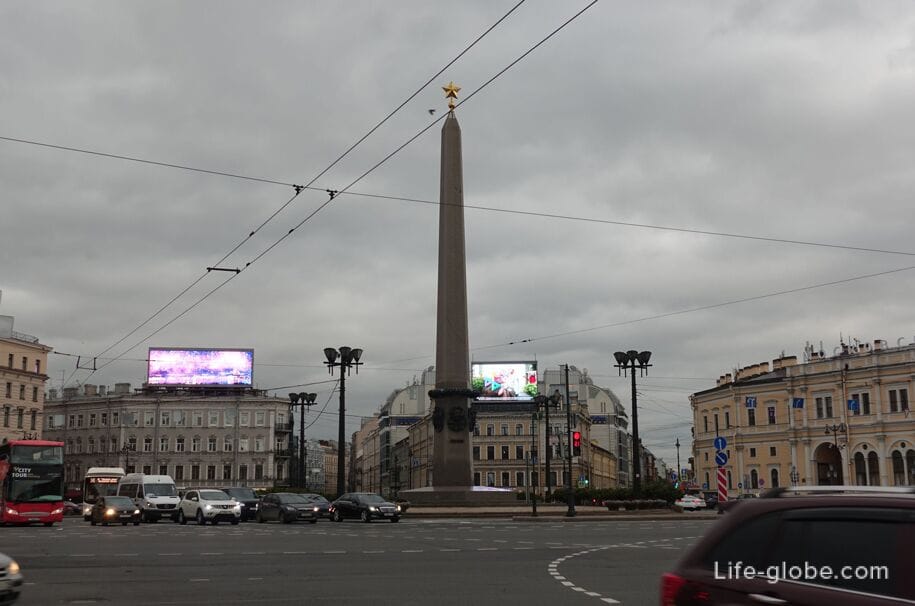
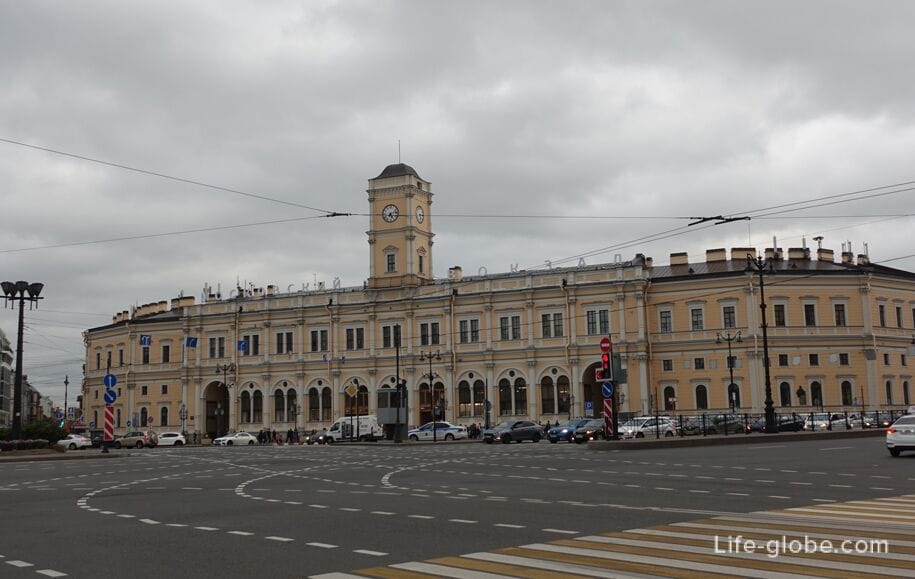
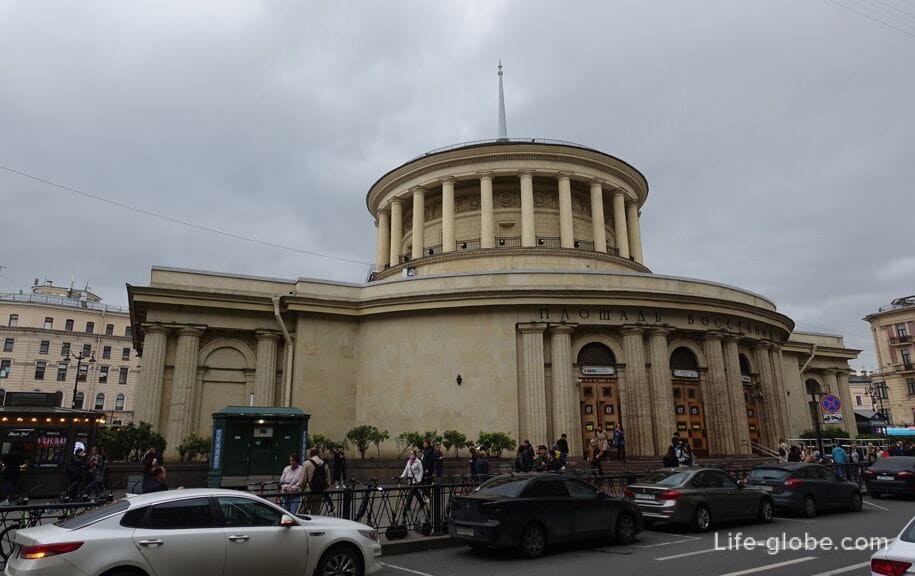
On the opposite side from the Moscow Railway Station, Vosstaniya Square is decorated with the building of the Oktyabrskaya Hotel, which is considered one of the oldest in St. Petersburg.
The hotel was built in 1845-1857 by the architect A. P. Gemilian. In the future, the building was rebuilt.
Initially, the hotel was called "Znamenskaya", then - "Severnaya" and "Bolshaya Severnaya", and after the revolution it became known as "Oktyabrskaya".
Today it is a functioning 4-star hotel Oktyabrskaya with a bar, a restaurant, free Wi-Fi, a 24-hour front desk, a fitness center, a beauty salon, conference rooms and meeting rooms.
Each roomhere will provide you with a private bathroom with a hairdryer, air conditioning, a refrigerator, a work desk, an eclectic kettle and a TV with satellite channels.
Breakfast can be included in the room rate. Link to the hotel
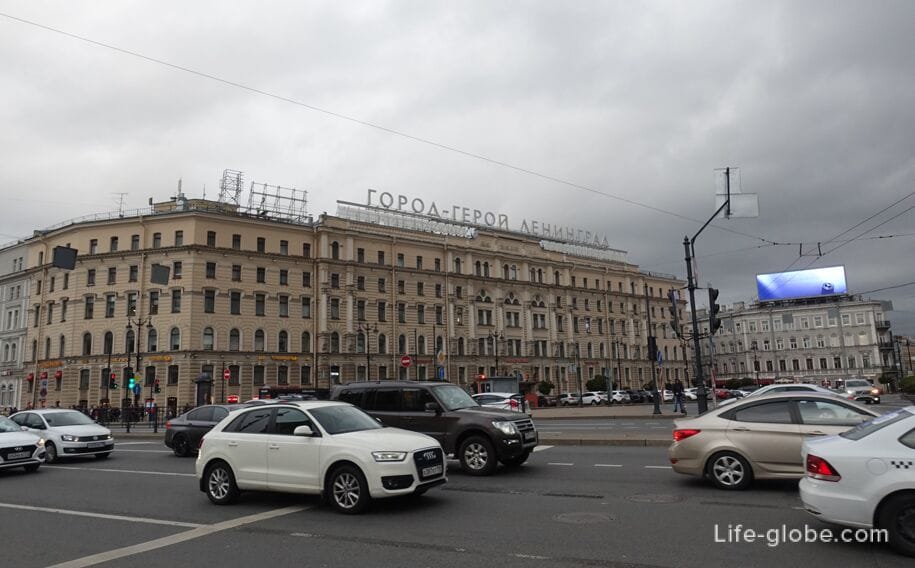
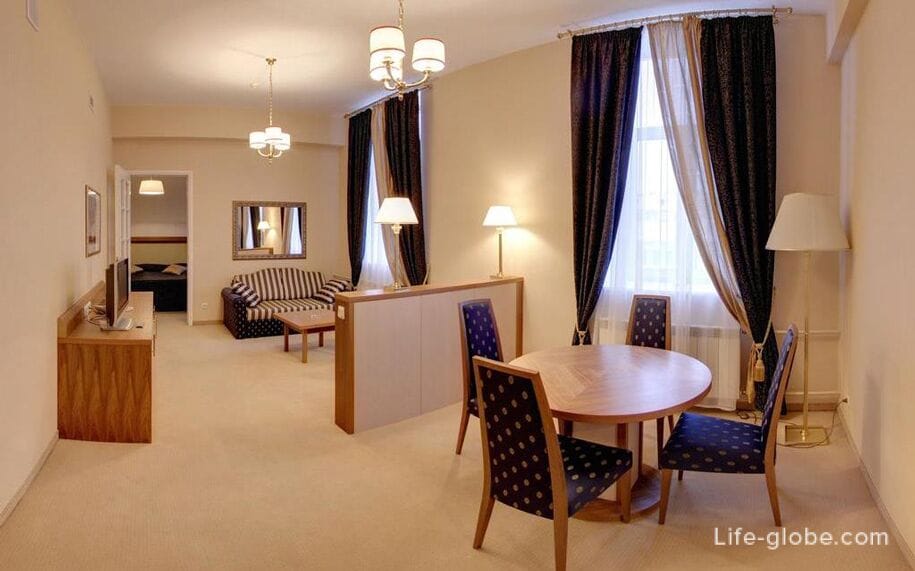
At this site, the so-called "Front" part of Nevsky Prospekt ends, followed by "Staro-Nevsky Prospekt". You can read about Nevsky Prospekt from Vosstaniya Square to the end of the avenue here...
Metro stations on Nevsky Prospekt and near the avenue: "Admiralteiskaya", "Nevsky Prospekt", "Gostiny Dvor", "Mayakovskaya", "Ploshchad Vosstaniya" and "Alexander Nevsky Square".
Public buses and trolleybuses run along Nevsky Prospekt and near the avenue.
You can visit Nevsky Prospekt either on your own or with one of the city tours
All accommodation facilities in St. Petersburg, including in the city center and on Nevsky Prospekt, can be viewed and booked here